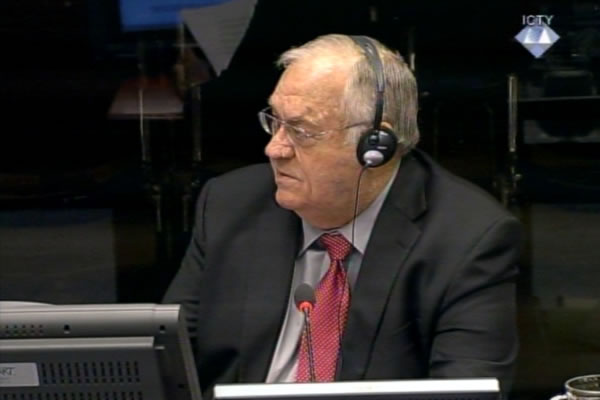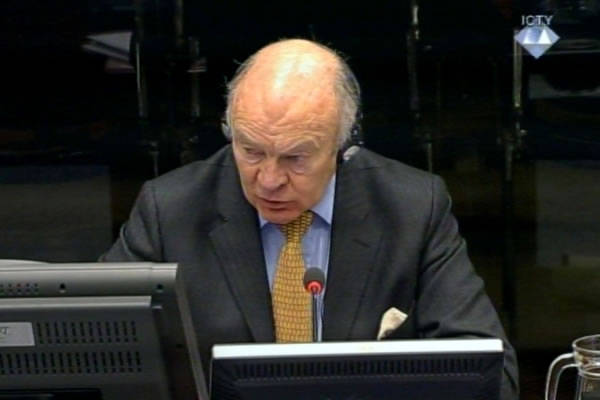Home
KARADZIC’S WITNESS: ‘BOMB THROWN AT MARKALE FROM A WINDOW’
A Canadian intelligence officer gave his evidence under protective measures. He claimed that he saw ‘from a distance of three meters’ a photo showing a bomb being thrown out of a window at the Markale town market in February 1994. The witness did not find it at all strange that the photo was purportedly taken from a place where 66 persons were killed and 140 wounded while the photographer and his camera remained unscathed. Two more military officers testified in Karadzic’s defense, one from the US and the other from Great Britain. The court also heard a former UNPROFOR soldier who testified with identity protection measures, in French
 Ronald Hatchett, defence witness of Radovan Karadzic
Ronald Hatchett, defence witness of Radovan Karadzic No less than four defense witnesses gave their evidence as the trial of Radovan Karadzic continued on Wednesday. First, US military officer and professor Ronald Hatchett was cross-examined by the prosecution. After he and his colleagues from the Lord Byron Foundation visited Pale in September 1994, Hatchett was impressed by Karadzic’s commitment to peace.
In the cross-examination, Hatchett said he knew there were numerous crimes in BH, but he was not sure to what extent Karadzic was responsible for them. It was the witness’s impression that the Bosnian Serb army was an entity that was not under any political control. Prosecutor Tieger confronted the witness with the evidence showing that after Zvornik was captured in the spring of 1992, Karadzic met with the local leaders who told Karadzic that they had been ‘actively throwing out Muslims’ and that they planned to settle ‘Serb children’ in the neighboring villages. Professor Hatchett replied that he didn’t know anything about that.
The chairman of the Lord Byron Foundation is an American Serb, Srdja Trifkovic, who is well-known for his nationalist views. The prosecutor singled out a number of his statements in which Trifkovic compared the Tribunal in The Hague with Stalin’s justice and warned of the danger of a ‘green transversal’ in the Balkans: a contiguous territory under Muslim control. Other members of the foundation described BH as the ‘corner stone of the European Islamistan’. Hatchett remarked he didn’t necessarily share the opinions of his colleagues in the foundation.
British officer Vere Hayes was called next. In the spring of 1993, Hayes was chief of the staff of UNPROFOR in Bosnia; he took part in the negotiations to demilitarize Srebrenica. Hayes said that after the agreement was signed, he saw Naser Oric, who was armed, in the enclave. It was a violation of the agreement. After Hayes completed his evidence, Karadzic called a protected witness, KW 571 evidence. The only thing disclosed about the witness was that he investigated one of the two artillery attacks on the Markale market in Sarajevo. The court heard that this was the witness’s ‘first and last’ task of that nature. Before the investigation, the witness had undergone ‘a two-day training course’ in crater analysis. Most of his evidence was heard in closed session.
The next witness, KW 554, denied that the Serbs were responsible for the attacks on the Markale market and that Karadzic was involved in the Srebrenica genocide. However, it was not easy to identify what he based his claims on. The witness is a Canadian and in 1995 he served as an UNPROFOR officer in Zagreb. In the UNPROFOR HQ in Zagreb, the witness contends, it was ‘believed’ that Muslims were responsible for some of the most serious artillery attacks on Sarajevo, including the Markale market attacks. The witness claimed that on his arrival in Canada he saw Canadian intelligence documents which could not serve as a basis for the conclusion that Karadzic knew about the mass executions in Srebrenica in July 1995.
Before the cross-examination, prosecutor West noted that she would not be asking any questions about those documents. She hadn’t seen them, the prosecutor said, and the witness stated he didn’t have them and was only able to discuss them based on his recollection. Prosecutor West also remarked on the witness’s claim ‘that he heard’ that the bomb that hit the Markale market in February 1994 had been thrown out of a window of a building near the market. As the witness said, an American soldier told him he had a photo showing a man throwing the bomb.
In the cross-examination, the witness corrected his claim, saying ‘I don’t know why I said that I only heard about the photo’ when in fact he saw it. An unknown American soldier showed the photo to the witness from a distance of at least three meters, the witness explained. The prosecutor, somewhat taken aback, asked the witness how big the photo was. The witness replied that it was of ‘a normal size’. This surprised the prosecutor even more, and she asked the witness whether he could discern anything in it. ‘Well, the soldier showed it to me very briefly and I couldn’t see clearly what it was’, the Canadian officer responded calmly. The prosecutor finally put it to him that the photo of the exact moment when the bomb was thrown out of the window onto the market had to have been taken from the ground. That meant that the ‘photographer and the camera had to come out unscathed out of an explosion that killed 66 and injured more than 140 persons.’ ‘Yes, that’s right’, the witness replied; it was apparent that he did not find this at all strange.
The trial of Radovan Karadzic continues tomorrow with the testimony of a new defense witness.Photos
Linked Reports
- Case : Karadzic
- 2013-01-15 HOW CLINTON SUPPORTED KARADZIC (TO NO AVAIL)
- 2013-01-14 KARADZIC’S DEFENSE WILL HAVE TO DO WITHOUT ORIC’S EVIDENCE, FOR THE TIME BEING
- 2012-12-20 MUSLIM CIVILIANS MOVED OUT ‘VOLUNTARY’
- 2013-01-17 KARADZIC’S HONEST WITNESS
- 2013-01-18 ‘MUJAHIDEEN TARGETED JEWS BUT HIT MARKALE MARKET’
- 2013-01-21 ‘VOLUNTARY’ ETHNIC CLEANSING

